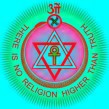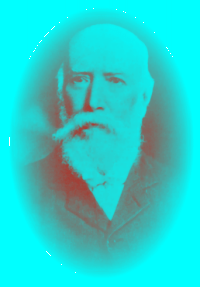The Writings of Alfred Percy Sinnett
Alfred
Percy Sinnett
1840
-1921
Return to
Esoteric Buddhism Index
Esoteric Buddhism
Preface to the Annotated Edition
SINCE this book was first published in the beginning of 1883, I
have come into possession of much additional information bearing on many of the
problems dealt with. But I am glad to say that such later teaching only reveals
incompleteness in my original conception of the esoteric doctrine, - no
material error so far. Indeed I have received from the great Adept himself,
from whom I obtained my instruction in the first instance, the assurance that
the book as it now stands is a sound and trustworthy statement of the scheme of
Nature as understood by the initiates of occult science, which may have to be a
good deal developed in the future, if the interest it excites is keen enough to
constitute an efficient demand for further teaching of this kind on the part of
the world at large, but will never have to be remodelled
or apologized for. In view of this assurance it seems best that I should now
put forward my later conclusions and additional information in the form of
annotations on each branch of the subject, rather than infuse them into the
original text, which, under the circumstances, I am reluctant in any way to
alter. I have therefore adopted that plan in the present edition.
As conveying an indirect acknowledgement of the general harmony to
be traced between these teachings and the recognized philosophical tenets of
certain other great schools of Indian thought, I may here refer to criticisms
on this book, which were published in the Indian magazine the Theosophist
in June, 1883, by “a Brahman Hindoo.” The writer
complains that in interpreting the esoteric doctrine, I have departed
unnecessarily from accepted Sanskrit nomenclature; but his objection merely is
that I have given unfamiliar names in some cases to ideas already embodied in Hindoo sacred writings, and that I have done too much
honour to the religious system commonly known as Buddhism, by representing that
as more closely allied with the esoteric doctrine than any other. “The popular
wisdom of the majority of Hindűs to this day,” says
my Brahman critic, “is more or less tinged with the esoteric doctrine taught in
Mr Sinnett’s book misnamed ‘Esoteric Buddhism,” while
there is not a single village or hamlet in the whole of India in which people
are not more or less acquainted with the sublime tenets of the Vedânta philosophy . . . . The effects of Karma in the next
birth, the enjoyment of its fruits, good or evil, in a subjective or spiritual
state of existence prior to the reincarnation of the spiritual monad in this or
any other world, the loitering of the unsatisfied souls or human shells in the
earth (Kâma loca), the pralayic
and manvantaric periods . . . . are
not only intelligible, but are even familiar to a great many Hindűs, under names different from those made use by the
author of ‘Esoteric Buddhism.’ “ So much the better,
-I take leave to rejoin, - from the point of view of Western readers, to whom
it must be a matter of indifference whether the esoteric Hindoo
or Buddhist religion is nearest to absolutely true spiritual science, which
should certainly bear no name that appears to wed it to any one faith in the
external world more than to another. All that we in Europe can be anxious for,
is to arrive at a clear understanding as to the essential principles of that
science, and if we find the principles defined in this book claimed by the
cultured representatives of more than one great Oriental creed as equally the
underlying truths of their different systems, we shall be all the better
inclined to believe the present exposition of doctrine worth our attention.
In regard to the complaint itself, that the teachings here reduced
to an intelligible shape are incorrectly described by the name this book bears,
I cannot do better than quote the note by which the editor of the Theosophist
replies to his Brahman contributor. This note says: -“We print the above letter
as it expresses in courteous language, and in an able manner, the views of a
large number of our Hindoo brothers. At the same time
it must be stated that the name of ‘Esoteric Buddhism’ was given to Mr Sinnett’s latest publication, not because the doctrine
propounded therein is meant to be specially identified with any particular form
of faith, but because Buddhism means the doctrine of the Buddhas,
the Wise i.e. the Wisdom Religion.” For my own part I need only add that I
fully accept and adopt that explanation of the matter. It would indeed be a
misconception of the design which this book is intended to sub-serve, to
suppose it concerned with the recommendation, to a dilettante modern
taste, of Old World fashions in religious thought. The external forms and
fancies of religion in one age may be a little purer, in another a little more
corrupt, but they inevitably adapt themselves to their period, and it would be
extravagant to imagine them interchangeable. The present statement is not put
forward in the hope of making Buddhists from among the adherents of any other
system, but with the view of conveying to thoughtful readers, as well in the
East as in the West, a series of leading ideas relating to the actual verities
of Nature, and the real facts of man’s progress through evolution, which have
been communicated to the present writer by Eastern philosophers, and thus fall
most readily into an Oriental mould. For the value of these
teachings will perhaps be most fully realized when we clearly perceive that
they are scientific in their character rather than controversial.
Spiritual truths, if they are truths, may evidently be dealt with in a no less
scientific spirit than chemical reactions. And no religious feeling, of
whatever colour it may be, need be disturbed by the importation into the
general stock of knowledge of new discoveries about the constitution and nature
of man on the plane of his higher activities. True religion will eventually
find a way to assimilate much fresh knowledge, in the same way that it always
finally acquiesces in a general enlargement of Knowledge on the physical plane.
This, in the first instance, may sometimes disconcert notions associated with
religious belief, - as geological science at first embarrassed biblical
chronology. But in time men came to see that the essence of the biblical
statement does not reside in the literal sense of the cosmological passages in
the Old Testament, and religious conceptions grew all the purer for the relief
thus afforded. In just the same way when positive scientific knowledge begins
to embrace a comprehension of the laws relating to the spiritual development of
man, -some misconceptions of Nature, long blended with religion, may have to
give way, but still it will be found that the central ideas of true religion
have been cleared up and strengthened all the better for the process.
Especially as such processes continue, will the
internal dissensions of the religious world be inevitably subdued. The warfare
of sects can only be due to a failure on the part of rival sectarians to grasp
fundamental facts. Could a time come when the basic ideas on which religion
rests, should be comprehended with the same certainty with which we comprehend
some primary physical laws, and disagreement about them be recognized by all
educated people as ridiculous, then there would not be room for very
acrimonious divergences of religious sentiment. Externals of religious thought
would still differ in different climates and among different races, - as dress
and dietaries differ, - but such differences would not give rise to
intellectual antagonism.
Basic facts of the nature indicated are developed, it appears to
me, in the exposition of spiritual science we have now
obtained from our Eastern friends. It is quite unnecessary for religious
thinkers to turn aside from them under the impression that they are arguments
in favour of some Eastern, in preference to the more general Western creed. If
medical science were to discover a new fact about man’s body, were to unveil
some hitherto concealed principle on which the growth of skin and flesh and
bone is carried on, that discovery would not be regarded as trenching at all on
the domain of religion. Would the domain of religion be invaded, for example,
by a discovery that should go one step behind the action of the nerves, and
disclose a finer set of activities manipulating these as they manipulate the
muscles? At all events, even if such a discovery might begin to reconcile
science and religion, no man who allows any of his higher faculties to enter
into his religious thinking would put aside a positive fact of Nature, plainly
shown to be such, as hostile to religion. Being a fact it would inevitably fit
in with all other facts, and with religious truth among the number. So with the great mass of information in reference to the spiritual
evolution of man embodied in the present statement. Our best plan
evidently is to ask, before we look into the report I bring forward, not
whether it will square in all respects with preconceived views, but whether it
really does introduce us to a series of natural facts connected with the growth
and development of man’s higher faculties. If it does this we may wisely
examine the facts first in the scientific spirit, and leave them to exercise
whatever effect on collateral belief may be reasonable and legitimate later on.
Ramifying, as the explanation proceeds, into a great many side
paths, it will be seen that the central statement now put forward constitutes a
theory of anthropology which completes and spiritualises
the ordinary notions of physical evolution. The theory which traces man’s
development by successive and very gradual improvements of animal forms
from generation to generation, is a very barren and miserable theory regarded
as an all-embracing account of creation; but properly understood it paves the
way for a comprehension of the higher concurrent process which is all the while
evolving the soul of man in the spiritual realm of existence. The present view
of the matter reconciles the evolutionary method with the deeply seated craving
of every self-conscious entity for perpetuity of individual life. The
disjointed series of improving forms on this earth have no
individuality, and the life of each in turn is a separate transaction which
finds in the next similar transaction, no compensation for suffering involved,
no justice, no fruit of its efforts. It is just
possible to argue on the assumption of a new independent creation of a human
soul every time a new human form is produced by physiological growth, that in
the after spiritual states of such soul, justice may be awarded; but then this conception
is itself at variance with the fundamental idea of evolution, which traces, or
believes that it traces the origin of each soul to the workings of highly
developed matter in each case. Nor is it less at variance with the analogies of
Nature; but without going into that, it is enough for the moment to perceive
that the theory of spiritual evolution, as set forth in the teaching of
esoteric science, is at any rate in harmony with these analogies, while at the
same time it satisfactorily meets the requirements of justice, and of the
instinctive demand for continuity of individual life.
This theory recognizes the evolution of the soul as a process that
is quite continuous in itself, though carried out partly through the
instrumentality of a great series of dissociated forms. Putting aside for the
moment of profound metaphysics of the theory which trace the principle of life
from the original first cause of the cosmos, we find the soul as an entity
emerging from the animal kingdom, and passing into the earliest human forms,
without being at that time ripe for the higher intellectual life with which the
present state of humanity renders us familiar. But through successive
incarnations in forms whose physical improvement, under the Darwinian law, is
constantly fitting them to be its habitation at each return to objective life,
it gradually gathers that enormous range of experience which is summed up in
its higher development. In the intervals between its physical incarnations it
prolongs and works out, and finally exhausts or transmutes into so much
abstract development, the personal experiences of each life. This is the clue
to the true explanation of that apparent difficulty which besets the cruder
form of the theory of reincarnation which independent speculation has sometimes
thrown out. Each man is unconscious of having led previous lives,
therefore he contends that subsequent lives can afford him no compensation for
this one. He overlooks the enormous importance of the intervening spiritual
condition, in which he by no means forgets the personal adventures and emotions
he has just passed through, and in the course of which he distills these into
so much cosmic progress. In the following pages the elucidation of this
profoundly interesting mystery is attempted, and it will be seen that the view
of events now afforded us is not only a solution of the problems of life and
death, but of many very perplexing experiences on the borderland between those
conditions - or rather between physical and spiritual life - which have engaged
attention and speculation so widely of recent years in most civilized
countries.
Return to
Esoteric Buddhism Index
___________________________________
Biography
For more info on Theosophy
Try these
Cardiff Theosophical Society meetings
are informal
and there’s always a cup of tea afterwards
The Cardiff Theosophical
Society Website
The National Wales Theosophy Wesbsite
Dave’s Streetwise Theosophy
Boards
If
you run a Theosophy Group then please
Feel
free to use any material on this Website
Theosophy
Cardiff’s Instant Guide to Theosophy
One
Liners & Quick Explanations
The main criteria for the
inclusion of
links on this site is that they are
have some
relationship (however tenuous) to
Theosophy
and are lightweight, amusing or
entertaining.
Topics include Quantum Theory
and Socks,
Dick Dastardly and Legendary Blues Singers.
No
Aardvarks were harmed in the
History
of the Theosophical Society
General pages about Wales,
Welsh History
and The History of Theosophy in
Wales
Her Teachers Morya & Koot Hoomi
The
Most Basic Theosophy Website in the Universe
If you run a Theosophy Group
you can use
this as an introductory handout
Lentil burgers, a thousand
press ups before breakfast and
the daily 25 mile run may put it
off for a while but death
seems to get most of us in the end.
We are pleased to
present for your consideration, a
definitive work on the
subject by a Student of Katherine Tingley entitled
Theosophy and the Number Seven
A selection of articles
relating to the esoteric
significance
of the Number 7 in Theosophy
The Spiritual Home of Urban Theosophy
The Earth Base for Evolutionary Theosophy
The Birmingham Annie Besant Lodge
_____________________
Camberley, Surrey, England GU15 - 2LF
Tekels Park to be Sold to a Developer
Concerns are raised about the fate of the wildlife as
The Spiritual Retreat, Tekels Park in Camberley,
Surrey, England is to be sold to a developer
Tekels Park is a 50 acre woodland park, purchased
for the Adyar Theosophical Society in England in 1929.
In addition to concern about the park, many are
worried about the future of the Tekels Park Deer
as they are not a protected species.
Many feel that the sale of a
sanctuary
for wildlife to a
developer can
only mean
disaster for the park’s animals
Confusion as the Theoversity
moves out of
Tekels Park to Southampton, Glastonbury &
Chorley in Lancashire while the leadership claim
that the Theosophical
Society will carry on using
Tekels Park despite its sale to a developer
Future of Tekels Park Badgers in Doubt
Tekels Park & the Loch
Ness Monster
A Satirical view
of the sale of Tekels Park
in Camberley,
Surrey to a developer
The Toff’s
Guide to the Sale of Tekels Park
What the men in
top hats have to
say about the sale
of Tekels Park
____________________
Theosophy Cardiff
Nirvana Pages
The Theosophy
Cardiff Guide to
The Theosophy Cardiff
Guide to
The
Theosophy Cardiff Guide to
The Terraced Maze of Glastonbury Tor
Glastonbury and Joseph of Arimathea
The
Grave of King Arthur & Guinevere
Views
of Glastonbury High Street
The
Theosophy Cardiff Guide to
__________________________
Classic Introductory Theosophy Text
A Text Book of Theosophy By C
What Theosophy Is From the Absolute to Man
The Formation of a Solar System The Evolution of Life
The Constitution of Man After Death Reincarnation
The Purpose of Life The Planetary Chains
The Result of Theosophical Study
An Outstanding
Introduction to Theosophy
By a student of
Katherine Tingley
Elementary Theosophy Who is the Man? Body and Soul
Body, Soul and Spirit Reincarnation Karma
Try these if you are
looking for a
local
Theosophy Group or Centre
UK Listing of
Theosophical Groups
Worldwide
Directory of Theosophical Links
General pages about Wales,
Welsh History
and The History of Theosophy in
Wales
Wales is a
Principality within the United Kingdom
and has an eastern
border with England.
The land area is
just over 8,000 square miles.
Snowdon in North Wales is the highest mountain at 3,650 feet.
The coastline is
almost 750 miles long.
The population of Wales as at the 2001 census is 2,946,200.



